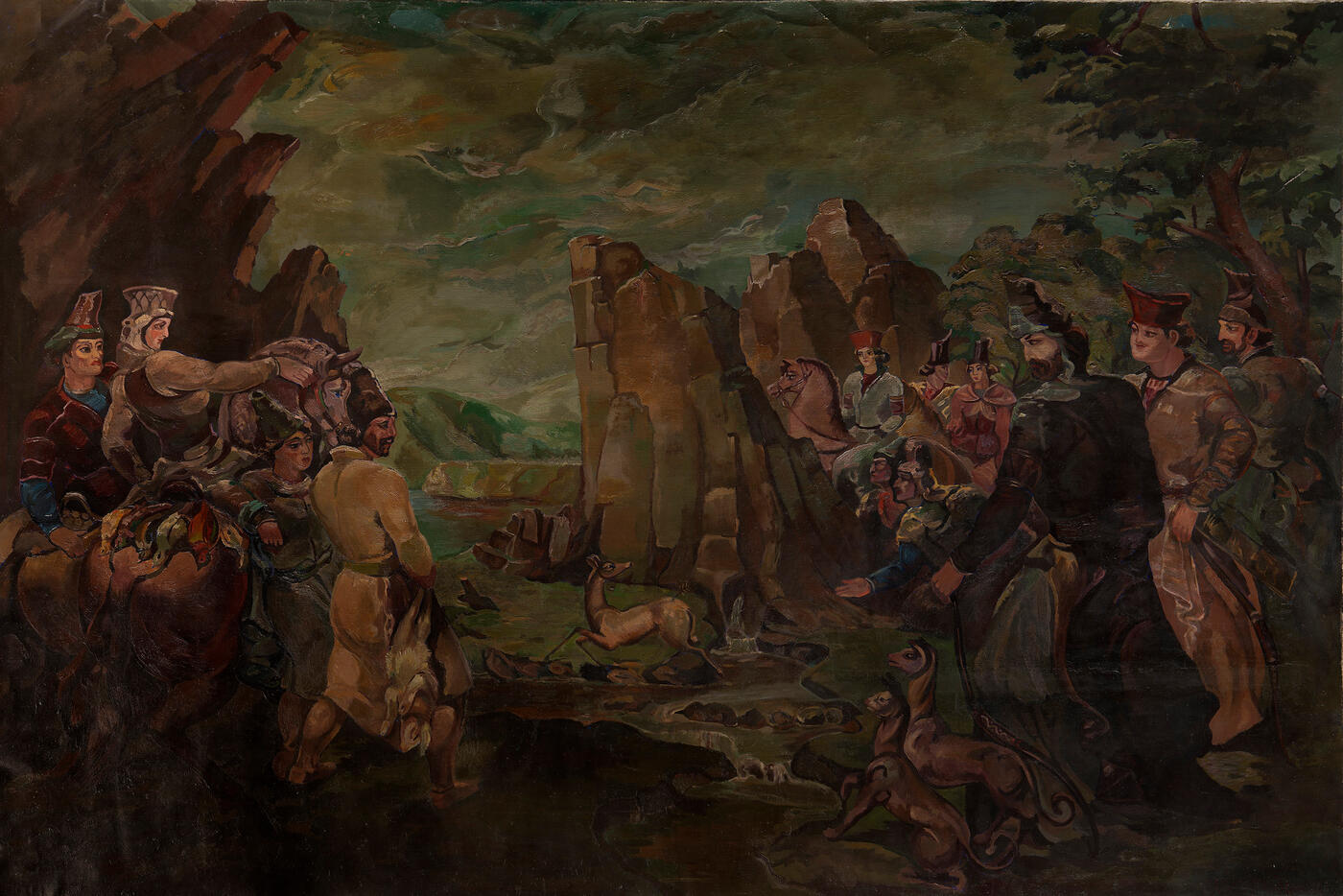8 June 2016 Russian Art and Photography Auctions
8 June 2016

* 12. GUDIASHVILI, LADO (1896-1980)
The Legend of the Founding of Tbilisi, signed.
Oil on canvas, 176.5 by 264 cm (canvas size).
200,000-250,000 GBP
Executed c. late 1940s.
Provenance: Acquired by the father of the present owner in Tbilisi c. 1950s.
Thence by decent.
Private collection, Europe.
Exhibited: Vystavka proizvedenii zasluzhennogo deyatelya iskusstv Gruzinskoi SSR khudozhnika Lado Gudiashvili, Tbilisi, 1957.
Literature: Exhibition catalogue, Katalog vystavki proizvedenii zasluzhennogo deyatelya iskusstv Gruzinskoi SSR khudozhnika Lado Gudiashvili, Tbilisi, Sakhelgami, 1957, illustrated.
The Legend of the Founding of Tbilisi is one of the best-known compositions that the great Georgian artist Lado Gudiashvili produced during the postwar period of his work. After returning from France to his native Georgia in 1925, Gudiashvili sought for some time to join the mainstream development of Soviet art, wholeheartedly devoting his decorativist talent to depicting the “new life” that was being built around him. However, from the second half of the 1930s onwards, fantasy and romanticism would gain prominence over real-world social themes. Inspired by a new archaeological discovery of an extensive burial sites at Armazi, near Georgia’s ancient capital, Mtskheta, Gudiashvili immersed himself in the world of his country’s legendary past, painting in 1940 his first large-scale historical picture.
The first version of The Legend of the Founding of Tbilisi was produced soon after, in 1945. The legend tells of how the site of the ancient Georgian capital had once been covered by impenetrable forests, where King Vakhtang I Gorgasali set off to hunt. As he pursued his quarry, the Georgian king wounded a deer, but the animal managed to hide in a ravine. Vakhtang and his attendants would give chase, before a miracle befell the hunting party: the deer plunged into a healing spring, its wound closed up and it escaped from its pursuers unscathed. Returning from the hunt, the king ordered that a city be built on that miraculous spot and that it be named “Tbilisi” in honour of the sacred waters (tbili means “warm” in Georgian, so Tbilisi is a “city of warm springs”).
Although Gudiashvili’s work did not concern itself with specific historical events, its theme, which offered broad scope for fantasy, won widespread acclaim. That proved to be sufficient as from then onwards, Gudiashvili’s own path in art and his highest artistic achievements were rooted in the realm of national history and Georgian legend, mythological themes and folklore characters, and an unreal country of a fairytale past, inhabited by fearless heroes and beautiful dancing damsels. The artist would turn to the theme of the founding of Tbilisi again and again, producing variations of the historical scene in the ravine right up to the 1960s.
Our canvas, painted in the 1940s, is among those Legends, replete with the light and colour, that celebrate the Golden Age of Georgia. Its composition, in which the galloping horsemen, the rocky peaks leaning towards the centre, the creature healed by the miraculous spring, the hunting dogs, the mountains and the quaint landscape intertwine with one another, constitutes a totally self-contained design. The hunting theme allows the artist to depict his favourite animals – deer, dogs and horses. Gudiashvili admitted that sometimes it was the opportunity to paint animals and their impulsive yet graceful movement that prompted him to take up his brush: “For me, a fallow deer is absolute beauty and grace… the embodiment of all that is pure and splendid. I regard it as a symbol of love, good and purity. A fallow deer is, after all, so supple and elastic. Its movements are amazingly graceful… Since I’ve started talking about this, I’ll also say that I’m generally very fond of drawing animals… The fallow deer and other deer are my favourite characters.”
As an artist who had previously felt the influence of compatriot Niko Pirosmani and the allure of European modernism, who had passed through the school of socialist realism and experienced a fascination for the conventionality of stage design, Gudiashvili arranged his composition according to the principle of mise-en-scène in theatre. Its defining quality is, above all else, decorativeness, ornamentality and a fluidity of lines in which correctness of perspective and anatomical accuracy may be sacrificed for the sake of expression and strokes of eloquence.
Yakov Tugendkhold, one of the most discerning of Soviet art historians, had good reason to comment that Gudiashvili’s painting always features “the severity of a Georgian fresco, the piquancy of a Persian miniature, the glistening of mosaics (and a small dash of Gauguin)”.
Notes on symbols:
* Indicates 5% Import Duty Charge applies.
Ω Indicates 20% Import Duty Charge applies.
§ Indicates Artist's Resale Right applies.
† Indicates Standard VAT scheme applies, and the rate of 20% VAT will be charged on both hammer price and premium.